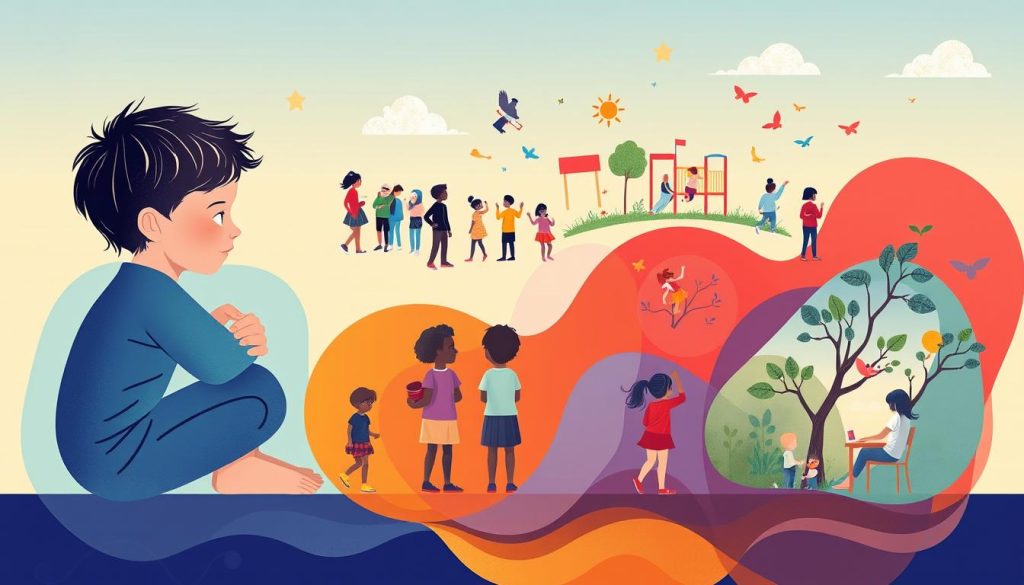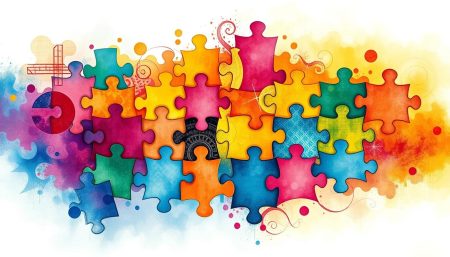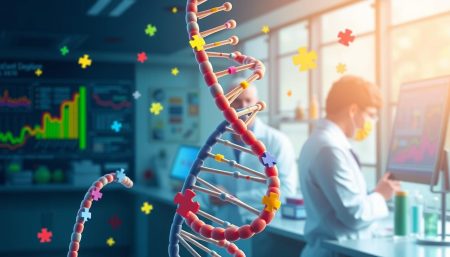Understanding ASD autism spectrum disorder symptoms is key for those who teach, support, and care for people with autism. Spotting autism signs early can greatly help in managing and improving their lives. This guide to autism symptoms offers vital info, highlighting the different ways ASD can show up. It’s important for creating effective help plans and making sure those with autism get the support they need.
Starting to understand ASD means looking for small signs that might show a person is different. With careful watching and knowing what autism signs are, parents, teachers, and doctors can start important talks and checks. Whether at school or home, finding these signs helps create a supportive space for growth and learning. Next, we’ll explore more about autism spectrum disorder, helping guide those through this complex condition.
Understanding Autism Spectrum Disorder
Autism Spectrum Disorder (ASD) is a wide range of conditions. It affects social skills, repetitive behaviors, speech, and nonverbal communication. Resources like the Autism Science Foundation, Centers for Disease Control and Prevention (CDC), and National Institute of Mental Health (NIMH) help us understand it better.
Definition and Overview
The definition of ASD shows it’s complex. It includes conditions like autistic disorder, PDD-NOS, and Asperger syndrome. Each person with ASD is different, with their own behaviors and severity levels.
The Spectrum Nature of ASD
ASD is called a spectrum because of its wide range of symptoms. It affects social interaction, speech, and nonverbal communication, along with repetitive behaviors. The term “spectrum” highlights the big differences among those with ASD.
| Feature | Impact |
|---|---|
| Social Interaction | Varies from mild impairments in socializing to severe challenges |
| Communication | Differences in verbal abilities, ranging from nonverbal to high verbal skill |
| Repetitive Behaviors | Can range from simple movements to complex rituals, impacting daily functioning |
ASD Autism Spectrum Disorder Symptoms
It’s important to know the signs of Autism Spectrum Disorder (ASD) to help manage it. The American Psychiatric Association’s DSM-5 lists various symptoms that differ from person to person. This part will look at common signs, helping those who care for or teach people with ASD to spot them.
Social Communication and Interaction Challenges: A key sign of ASD is trouble with social talking and interaction. This can show in many ways, such as:
- Unusual or unsuccessful response to social interactions
- Challenges in maintaining conversation
- Limited eye contact and lack of facial expressions
- Difficulty understanding and responding to social cues
Patterns of Behavior: People with ASD might have certain behaviors or interests that repeat. These can include:
- Repetitive motor movements or speech patterns
- Rigidity in routines, and distress at small changes
- Fixated interests that are abnormal in intensity or focus
- Hyper- or hypo-reactivity to sensory input
Spotting ASD means noticing these behaviors and how they affect daily life. Early help is key, as it can greatly improve a person’s life and growth. This guide is meant to help recognize ASD and encourage seeking professional help for a full check-up.
Signs of Autism in Children
It’s key to spot autism signs in kids early on. This helps them get the help they need sooner. We’ll look at signs in early childhood, focusing on social and communication skills.
Early Childhood Indicators
Autism signs in young kids can be different for everyone. They often show up in how kids act and talk. Parents and caregivers should watch for any big delays or odd behaviors in toddlers. Here are some important signs:
- Limited eye contact or trouble keeping eye contact.
- Not interested in playing with others or not answering to their name by 12 months.
- Doing the same actions over and over, like rocking or hand-flapping.
- Not talking or babbling by 15 months.
Social Interaction and Communication Challenges
Kids with autism might have trouble talking and playing with others. These signs are key to spotting autism early. They often include:
- Hard time sharing feelings or understanding others’ emotions.
- Struggling to start or keep a conversation going.
- Using words or phrases over and over instead of talking normally.
- Prefer playing alone instead of with others.
Knowing these signs can help find the right help. Bodies like the Center for Disease Control and Prevention (CDC) and the American Academy of Pediatrics suggest early checks and help.
Early Signs of Autism in Toddlers
Spotting autism in toddlers early is key for help and support. Signs of autism in toddlers include certain behaviors and milestones. This section will explain these signs clearly, with help from the National Institute on Deafness and Other Communication Disorders (NIDCD).
Early signs include trouble with social interactions, like eye contact and understanding feelings. Speech delays or odd speech patterns are also signs. Other signs are repetitive movements, strict routines, and unusual reactions to sounds or sights.
- Lack of or delay in spoken language
- Repetitive use of language or motor mannerisms
- Little or no eye contact
- Consistent preference for solitude
- Difficulty understanding, or lack of interest in, other people’s feelings
- Remains non-responsive to verbal cues
Watching for these signs and talking to healthcare providers is important. Early detection and diagnosis help manage autism and support the toddler’s growth.

| Age | Expected Milestones | Signs of Possible Autism |
|---|---|---|
| 12 Months | Uses simple gestures (e.g., waving bye-bye) | Lack of gestures |
| 18 Months | Imitates words and actions | Minimal verbalization, no imitation |
| 24 Months | Begins two-word phrases | Repeats words or phrases (echolalia) |
The table shows typical milestones and signs of autism. It helps spot when a child is not meeting expected milestones. If you notice these signs, talk to a professional for an evaluation.
Autism Diagnosis Criteria
Getting an accurate autism diagnosis is key. It uses detailed criteria and thorough ASD assessments. These steps follow guidelines from the World Health Organization, Autism Speaks, and the National Institute of Neurological Disorders and Stroke. This part explains how experts do these assessments and what they look for.
Professional Assessment Processes
ASD assessment is a complex task needing medical and psychological skills. Psychologists and psychiatrists do interviews and watch how the person interacts. They might use the Autism Diagnostic Observation Schedule (ADOS) or the Autism Diagnostic Interview-Revised (ADI-R).
These tools help see how well someone communicates, interacts socially, and uses their imagination. They are tailored for different age groups.
Key Factors in Diagnosing Autism
Experts look for signs of trouble in social communication and interaction. This starts early in life. It shows in not wanting to share feelings or start conversations.
They also check for repetitive behaviors or interests. These must really affect someone’s life and not be due to other issues like low intelligence or developmental delays.
img src=”https://seowriting.ai/32_6.png” alt=”Professional ASD assessment tools”>
Exploring Asperger’s Syndrome Symptoms
This section looks closely at the traits linked to Asperger’s Syndrome, now seen as part of high-functioning autism. People with this condition often have special thinking skills but struggle with social interactions.
Asperger’s symptoms highlight unique social and communication traits. Unlike others on the autism spectrum, they usually don’t have language delays. Yet, they find social interactions and nonverbal communication very hard. These differences are key to grasping high-functioning autism.
Key symptoms include:
- Limited or awkward social interactions
- An intense focus on single subjects or ideas
- Unusual speech patterns, such as speaking in a monotone
- A strong preference for routines and schedules
Studies show that high-functioning autism doesn’t slow down thinking. But it makes emotions more intense, making social life and relationships tough.
| Aspect | Expression in High-Functioning Autism |
|---|---|
| Communication | Formal, detailed, sometimes overly factual |
| Social Interaction | Difficulty reading nonverbal cues, prefers solitude |
| Routines | Reliance on strict routines to manage daily activities |
| Focus Areas | Deep, narrow interests often perceived as obsessive |
Understanding these traits in high-functioning autism helps us see daily challenges. It also shows the need for special support and help. This can improve social life and overall well-being.
Typical ASD Behavior Patterns
Understanding ASD behavior patterns and sensory processing in ASD is key. It helps us see how people with autism interact with their world. These patterns are unique and greatly affect their daily lives.
Repetitive Behaviors and Routines
Many with autism depend on routines and show repetitive behaviors. These routines bring order and predictability, which is comforting. It helps them cope with a chaotic world.
These behaviors can be simple, like hand-flapping, or complex, involving many steps. They help individuals feel secure in an unpredictable world.
Response to Sensory Input
People with autism often have different sensory processing. They might be more or less sensitive to sensory stimuli. This affects their behavior, as they seek certain sensory experiences or avoid overwhelming places.
| Behavior Pattern | Explanation | Common Challenges |
|---|---|---|
| Repetitive Movements | Engaging in motion like rocking or twirling | May interfere with daily activities |
| Ritualistic Routines | Insistence on following specific routines | Disruption causes significant distress |
| Sensory Seeking | Craving certain textures or sounds | May lead to socially inappropriate behavior |
| Sensory Avoidance | Avoiding overwhelming situations | Can limit exposure to new experiences |
Both ASD behavior patterns and sensory processing in ASD shape how individuals with autism see and react to their environment. They influence social interactions and life experiences.
Identification and Management of ASD in Adults
Understanding autism in adults and managing adult ASD are key to better lives for those with autism and their families. This part explores how to identify and manage autism in adults.
Diagnosing autism in adults is hard because symptoms can look like other conditions. Many adults find out they have autism when their child is diagnosed. This makes them look into their own symptoms.
| Challenges | Management Strategies |
|---|---|
| Social Interaction Difficulties | Tailored social skills training |
| Uneven Job Performance | Workplace accommodations and supports |
| Managing Daily Living | Structured routine and visual aids |
| Stress & Anxiety | Cognitive behavioral therapy |
After getting a diagnosis, the focus is on managing adult ASD. This includes psychological support, vocational training, and social strategies. A team of experts helps create a management plan.
- Continued education on understanding autism in adults
- Peer support groups for shared experiences and strategies
- Modern assistive technologies for communication and organization
The aim of managing adult ASD is to help people live fulfilling lives. With the right support, adults with autism can succeed in many areas of life and work.
Understanding Autism in Adults
Living with autism doesn’t stop when you grow up. Adults with autism face new challenges in work and social life. Learning about workplace challenges for autistic adults and adult autism social relationships helps improve support and understanding.
Challenges in the Workplace
Autistic adults often struggle in the workplace. They might find office lights or noise too much. They also have trouble reading non-verbal cues from coworkers.
Having a structured work environment and clear rules helps them a lot. Things like quiet workspaces and clear communication make work better for them. This creates a more welcoming work place.
- Adaptations to the physical workspace
- Enhanced communication strategies
- Customized performance evaluation methods
Social Relationships and Autism in Adulthood
Adults with autism find social interactions hard. Adult autism social relationships need a lot of social understanding. This can be tough for them.
Learning social skills and having supportive friends helps a lot. It makes their social life better. Social groups and activities for autistic adults are also very helpful.
These groups offer a safe place for socializing and making friends. They help autistic adults learn and grow socially. This is key for a fulfilling life.
For more on autism and mental health, and how to support autistic adults, check out this detailed guide on understanding autism spectrum disorder.
Intervention Strategies for Autism Spectrum Disorder
Autism therapeutic approaches and ASD intervention strategies are key for those with autism spectrum disorder (ASD). They help with communication, social skills, and behavior. Early, tailored interventions can lead to big improvements, say experts from the American Speech-Language-Hearing Association (ASHA) and Autism Speaks.
There are many ASD intervention strategies, each for different needs. We look at some effective methods backed by research. They help improve life for those on the spectrum.
- Behavioral Interventions: These are core in ASD treatment. Applied Behavior Analysis (ABA) uses rewards to encourage good behavior and avoid bad ones.
- Speech and Language Therapy: It’s vital for better communication skills. Experts from ASHA and Autism Speaks often recommend it.
- Occupational Therapy: It helps with daily living, sensory-motor skills, and coordination.
- Social Skills Training: It aims to improve how individuals with ASD interact with others.
- Parent-mediated Interventions: It teaches parents how to support their child’s learning and growth.
Using these autism therapeutic approaches in a treatment plan can make a big difference. It’s important for caregivers to work with healthcare experts. This ensures the interventions fit the person’s changing needs.
Autism Spectrum Disorder Treatment Options
Looking into autism spectrum disorder treatment options is key for better outcomes. Many ASD therapies help improve communication, behavior, and social skills. This is important for those with autism.
Behavioral Therapies and Supports
Behavioral therapies are a big part of autism treatment. They work on making good behaviors stronger and bad ones weaker. Applied Behavior Analysis (ABA) is a top choice. It teaches new skills and helps with autism challenges in a structured way.
Communication and Social Skills Training
Improving how people talk and interact is a main goal of ASD therapies. Speech therapy and social skills classes are big helps. They let people do better in social situations.
| Therapy Type | Focus Area | Expected Outcome |
|---|---|---|
| Behavioral Therapy | Behavior Modification | Improved behavior management |
| Communication Training | Language Skills | Enhanced verbal and non-verbal communication |
| Social Skills Training | Interpersonal Interactions | Enhanced social engagement |
In short, the right autism spectrum disorder treatment options can make a big difference. They help people with ASD become more independent and social.
Navigating Educational Systems for Children with ASD
Teaching children with autism needs special care and services. It’s important to know their rights and the help they can get. This helps them learn better and reach their full potentials.
The U.S. Department of Education and groups like the Autism National Committee (AutCom) stress the need for good education. They push for changes in schools to meet the needs of autistic students. Parents and guardians can find support in several areas:
- Individualized Education Programs (IEPs): IEPs are plans made for each student with special needs. They ensure the right education and support.
- Inclusion Programs: These programs help autistic students learn in regular classrooms. They get the support they need to succeed.
- Special Education Services: These services focus on skills like communication and social skills. They help students do well in school.
- Parental and Guardian Guidance: Families get help and workshops. This helps them understand and advocate for their child’s education.
Working together, teachers, therapists, and families create a supportive learning space. This space helps autistic children succeed academically and personally.
The Role of Family in Supporting Individuals with Autism
The family’s role in supporting those with autism is very important. A caring and understanding family is key to managing autism’s challenges. This section offers practical tips for creating a supportive home environment that promotes health and development.
Creating a Supportive Home Environment
To create a supportive home, you need to make physical changes and offer emotional support. It’s important to ensure safety, reduce sensory overload, and establish routines. Each family must tailor these suggestions to meet their specific needs.

Resources and Support for Siblings and Families
Siblings and extended family members also need support and resources. Parents can help by educating them about autism. This helps siblings understand and empathize with their family member’s challenges.
| Resource Type | Benefit | Recommended For |
|---|---|---|
| Sibling Workshops | Build empathy, understanding | Siblings of all ages |
| Support Groups | Shared experiences, coping strategies | Parents and caregivers |
| Educational Materials | Increased awareness, effective communication | Families and friends |
| Home Adjustment Consultations | Tailored advice for creating a supportive environment | Families living with individuals on the autism spectrum |
Investing in these resources helps families support their member with autism better. It also improves their own understanding and coping with autism spectrum disorder.
Advancements in Autism Research and Future Prospects
The world of autism research advancements is always changing. It’s helping us understand and treat Autism Spectrum Disorder (ASD) better. Groups like the Simons Foundation Autism Research Initiative (SFARI) and the National Institute of Mental Health (NIMH) are leading the way. They show us a bright future for ASD treatment.
New studies are looking at genetic markers and brain functions. This gives us new ideas for better treatments. The SFARI is making big strides in this area. They’ve found genetic links to ASD, which could lead to more personalized care soon.
The NIMH is also playing a key role. They’re funding research into special therapies for ASD. These therapies aim to improve social skills and lessen symptoms. They’re a big part of the progress in autism research advancements.
- Development of new diagnostic tools for early detection
- Improvements in personalized treatment plans
- Increased understanding of environmental factors in ASD
Together, these efforts are changing how we treat and manage autism. They promise a future where we can help people with ASD in a more complete and caring way.
Community Resources and Support Networks for Autism
Dealing with Autism Spectrum Disorder (ASD) is tough. It needs a supportive community that gets it. Autism support networks are key. They offer help and services for those with ASD and their families.
Groups like Autism Speaks have a Resource Guide. It’s full of useful info for finding help. It helps people find educational programs and therapists who know about sensory integration.
The Autism Society is another big help. They have Local Chapters all over the U.S. These chapters offer support and help connect people with ASD to therapists and healthcare providers.
They also have support groups and fun activities. These are made for people with ASD. The Autism Society also helps with family care, education, and advocacy.
Working towards a world that includes everyone with autism is ongoing. Strong support networks are vital. As more people find help, those with ASD can live better lives.
Every effort, big or small, helps. It’s all about creating a network of hope and help across the country.
FAQ
Q: What is Autism Spectrum Disorder (ASD)?
A: Autism Spectrum Disorder (ASD) is a condition that affects how people communicate and behave. It shows up in different ways, which is why it’s called a spectrum. Symptoms often start in early childhood and can affect daily life.
Q: What are the early signs of autism in children?
A: Early signs include not making eye contact, not responding to their name, and unusual play. They might also struggle with changes in routine and have delayed speech. Parents should watch for these signs and talk to doctors if they’re worried.
Q: How is autism diagnosed in children and adults?
A: Diagnosing autism involves several steps. This includes developmental screenings and detailed evaluations. For adults, it also looks at current symptoms and childhood behavior. Psychological tests are often part of the process.
Q: Can autism be cured?
A: There’s no cure for autism, but treatments can greatly improve life. Behavioral therapies and educational support are effective. These help individuals with autism live better lives.
Q: What treatment options are available for Autism Spectrum Disorder?
A: Treatments for ASD include behavioral therapy, speech therapy, and occupational therapy. Physical therapy and medication might also be used. The right treatment depends on the individual’s needs.
Q: What are the most common behavior patterns associated with ASD?
A: People with ASD often repeat behaviors and stick to routines. They might be very sensitive to sounds or lights. They also have strong interests in specific topics or objects.
Q: What challenges do adults with autism face in the workplace?
A: Adults with autism might struggle with social interactions and adapting to changes. But, with the right support, they can do well at work. Accommodations and understanding help them succeed.
Q: How can families support individuals with autism?
A: Families can help by creating structured environments and encouraging open communication. They should also participate in therapy and advocate for their loved one’s rights. Support groups and resources are also helpful.
Q: Are there resources available for siblings and families of individuals with ASD?
A: Yes, many organizations offer support for families. They provide education programs, support groups, and resources. This includes workshops, information, and respite care services.
Q: What recent advancements have been made in autism research?
A: New research focuses on genetics, early screening tools, and better treatments. Studies on brain flexibility and therapy effectiveness are ongoing. These advances aim to improve understanding and treatment of autism.
Q: How can I find community resources and support networks for autism?
A: Look for resources through organizations like Autism Speaks and the Autism Society. They offer directories of local services, support groups, and educational resources. These tools help families and individuals with autism.


















